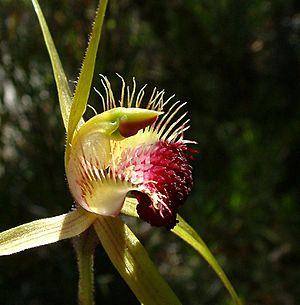Grand spider orchid facts for kids
Quick facts for kids Grand spider orchid |
|
|---|---|
 |
|
| Conservation status | |
| Scientific classification | |
| Genus: |
Caladenia
|
| Species: |
huegelii
|
| Synonyms | |
|
|
The Caladenia huegelii, also known as the grand spider orchid, is a special type of orchid. It grows only in the south-west part of Western Australia. This orchid has a single, fuzzy leaf and usually up to three large flowers. These flowers are a mix of red, green, and cream colors. They have unique "split-hairs" on the sides of their labellum (the orchid's special lip petal).
What Does It Look Like?
The grand spider orchid is a plant that grows from the ground. It's a perennial herb, meaning it lives for more than two years. It also has an underground tuber, which is like a storage root. The plant has one straight, hairy leaf that is about 100–180 mm (4–7 in) long and 7–12 mm (0.3–0.5 in) wide.
The flowers grow on a stem that can be 250–600 mm (10–20 in) tall. Each flower is quite big, about 70–120 mm (3–5 in) long and 70–100 mm (3–4 in) wide. They are usually pale greenish-yellow with red marks.
The sepals (leaf-like parts that protect the flower bud) are also interesting. The top sepal stands up straight. The two side sepals are almost parallel to each other and have club-like tips that are light brown or yellow. The petals (the colorful parts of the flower) are about 130–60 mm (5–2 in) long and sometimes curve downwards.
The labellum (the orchid's lip) is about 25–30 mm (0.98–1.2 in) long. It's greenish-cream with a red tip that is often turned under. The sides of the labellum have many thin "teeth" that can be up to 15 mm (0.6 in) long and are often split. There are also four rows of dark red bumps, called calli, along the center of the labellum. This orchid blooms from September to late October.
How It Was Named
The grand spider orchid was first officially described in 1871. A scientist named Heinrich Reichenbach wrote about it. He found a sample of the plant near the Swan River. The name huegelii was given to honor Baron Charles von Hügel, a famous person who studied plants.
Where It Lives
This special orchid grows between the cities of Perth and Capel in Western Australia. It likes to grow in deep sandy soil found in woodlands. These areas are part of the Jarrah Forest and Swan Coastal Plain regions.
Protecting This Orchid
The grand spider orchid used to be quite common. However, because more and more towns are being built in its habitat, many groups of these orchids have disappeared. Out of 33 known groups of these plants, about 85% of them are found in just four main locations. This means most of the remaining 1,500 plants are in very few spots.
This orchid faces several dangers. These include losing its home due to new buildings, weeds taking over its growing areas, and a plant disease caused by Phytophthora cinnamomi.
Because of these threats, the Western Australian Government's Department of Parks and Wildlife has listed it as "Threatened Flora." This means it's a rare plant that needs protection. The Australian Government has also listed it as "Endangered" under the Environment Protection and Biodiversity Conservation Act 1999 (EPBC Act). This shows how important it is to protect this unique orchid.


